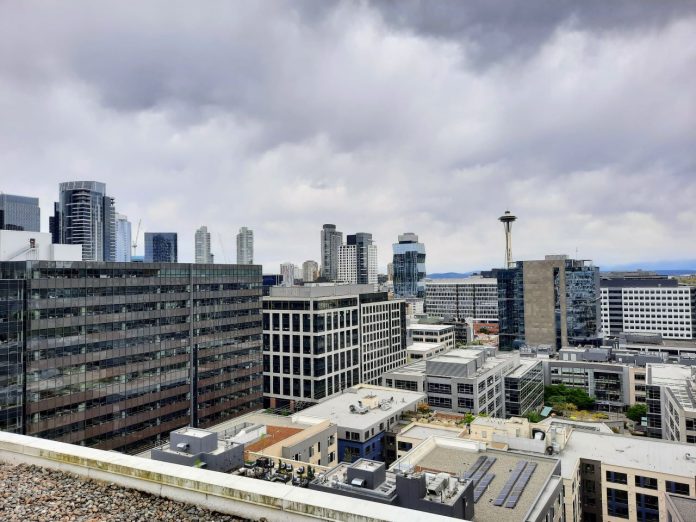
Seattle could soon be more populous than San Francisco, based on current trends.
New state population estimates released Friday revealed that Seattle is on the cusp of crossing the 800,000 mark. The annual April 1 population estimates from the Washington State Office of Financial Management (OFM) have showed Seattle steadily growing since a brief pandemic dip and hitting 797,700 in April 2024.
The recent trend line suggests Seattle will surpass 800,000 by a comfortable margin by the next round of estimates in April 1, 2025. That said, the real estate industry has warned of a homebuilding slowdown, which could cut into momentum, and housing advocates have warned that Seattle’s once-a-decade growth plan update aims too low, failing to target enough housing creation. Still, it’s been an impressive decade of growth for Seattle, which crossed the 700,000 mark in 2017 and the 600,000 mark around 2009. Growing by more than 100,000 residents per decade is turning into a pattern.

Seattle led the state in population growth by a wide margin, continuing a recent trend of urbanization in the Evergreen State. Still, several other Washington cities reached milestones of their own.
Vancouver added 3,000 residents, surpassing 200,000 for the first time, reaching 202,600. That was second largest numeric gain, with Tacoma in third-place with a population increase of 2,700, putting Tacoma’s new estimate at 225,100. Redmond was fourth, adding 2,550 residents and surpassing 80,000 for the first time. Home to Microsoft’s headquarters, Redmond recently opened its first two light rail stations, pointing to more momentum for growth.
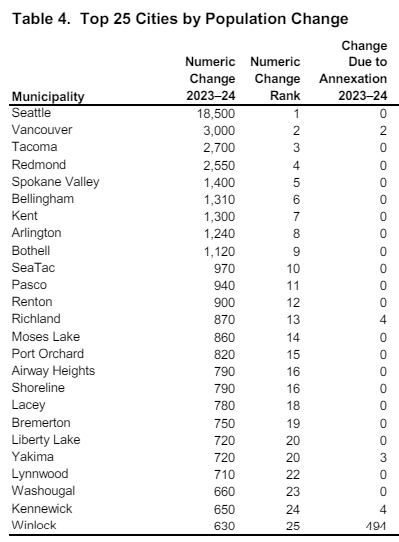
Another major milestone: Washington state crossed the eight million mark for the first time, growing by an estimated 84,550 residents to reach 8,035,700.
Migration has been the main driver of Washington’s population gains: “Net migration (people moving in minus people moving out) is the largest driver of population growth, accounting for 82% of population growth (69,100 people, down 3,300 from last year),” OFM wrote in its press release. “Natural change (births minus deaths) accounted for 18% of the annual growth or 15,500 people.”
King County grew to 2,378,100 residents, up 30,300 residents from 2,347,800 in 2023. Seattle carried over 60% of the county's growth.
— The Urbanist (@UrbanistOrg) June 28, 2024
King County led the state in population growth, with Seattle accounting for more than 60% of the surge in Washington’s largest county.
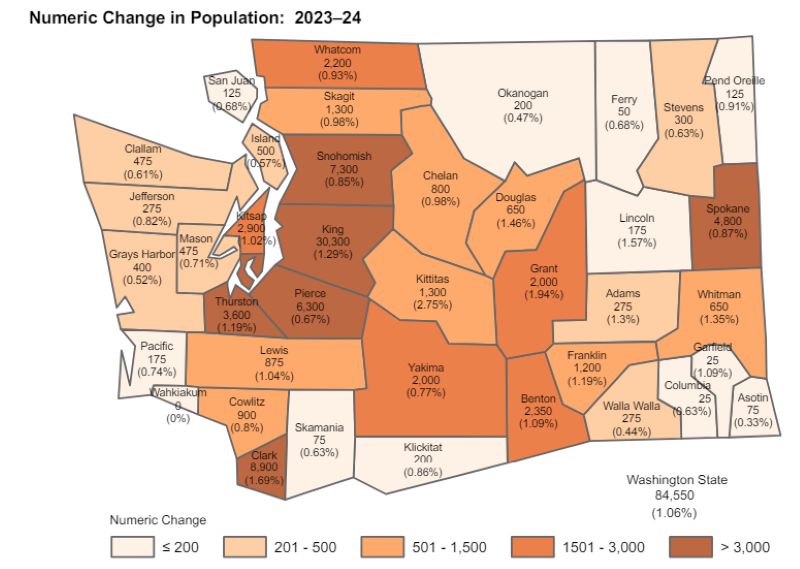
In contrast to the big urban county gainers, several more remote rural counties saw essentially flat growth rates, according to OFM’s estimates. On the other hand, a few largely rural counties like Kittitas just east of King County grew relatively quickly, posting a 2.75% growth rate.
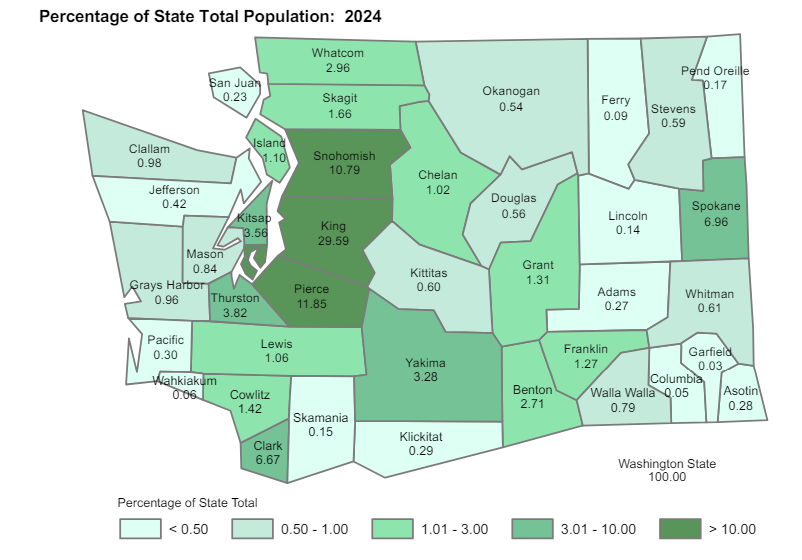
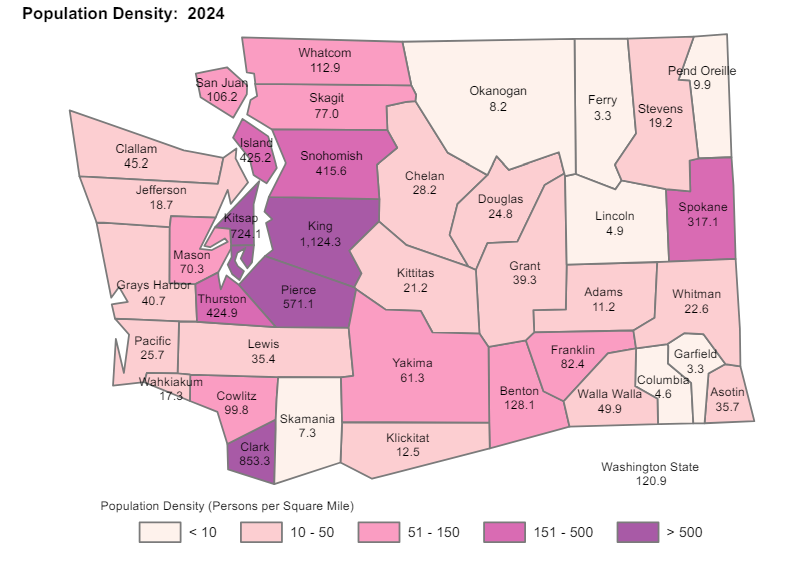
Washington is one of the fastest growing states in the union, posting a 14.6% growth rate between 2010 and 2020, just ahead of Florida and just behind Texas and Utah. Given the lead Virginia (#12) has, it would take some time to climb the ranks, but Washington’s position as the 13th most populous state appears assured for the time being — even as Arizona (#14) soaks up retirees like nobody’s business.
Seattle’s population gain, meanwhile, could soon propel it past shrinking San Francisco in population rankings. The cities sit at 18th and 17th in the nation, respectively. The 2020 census had put San Francisco at 873,965, but the city has shrank significantly since then. Just how much is a point of disagreement. The US Census Bureau’s last estimate put San Francisco around 809,000 residents, but the State of California’s estimate was 843,071 as of January 2024. Either way, fast-growing Seattle is on pace to surpass its slow-growing neighbor to the south and jump its fellow tech capital in population rankings.
Seattle builds homes at a much faster rate than famously persnickety San Francisco. Relatedly, Seattle housing prices are much lower than the Bay Area despite experiencing similar tech booms. The median rent in Seattle is $2,166 versus $3,330 in San Francisco, according to Zillow. The median home price is $1.3 million in San Francisco, nearly 50% higher than in Seattle. The housing boom has helped avoid the Puget Sound the extreme housing dysfunction of the Bay Area.
Nonetheless, Seattle has not fully bought into the path of homebuilding its way out of housing crisis. Mayor Bruce Harrell’s draft Seattle Comprehensive Plan scaled back his own planning department proposal, apparently in the name of not rocking the boat and shielding single family zoned areas from additional housing options. The goal from the Harrell Administration (and King County planners) to add at least 100,000 new homes over the next 20 years would not be enough to accommodate Seattle adding another 225,000 residents over the next 20 years, like it did over the past 20 years — let alone a more rapid gain.
A timid growth plan could end up sapping the momentum the city has on housing growth and avoiding San Fran-style rent hikes.
Doug Trumm is publisher of The Urbanist. An Urbanist writer since 2015, he dreams of pedestrianizing streets, blanketing the city in bus lanes, and unleashing a mass timber building spree to end the affordable housing shortage and avert our coming climate catastrophe. He graduated from the Evans School of Public Policy and Governance at the University of Washington in 2019. He lives in East Fremont and loves to explore the city on his bike.


